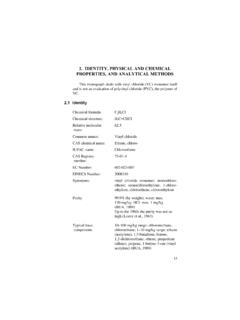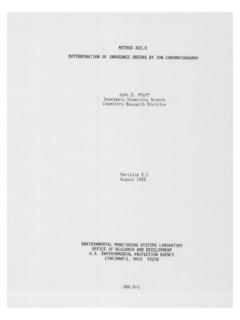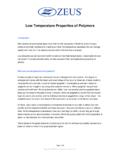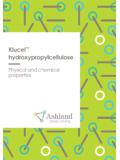Transcription of HYDROGEN SULFIDE 6013
1 HYDROGEN SULFIDE 6013. H2S MW: CAS: 7783-06-4 RTECS: MX1225000. METHOD: 6013, Issue 1 EVALUATION: FULL Issue 1: 15 August 1994. OSHA : C 20 ppm; P 50 ppm/10 min PROPERTIES: gas; d (liq) g/mL @ 0 C;. NIOSH: C 10 ppm/10 min BP - 60 C; VP 20 atm @ 25 C;. ACGIH: 10 ppm; STEL 15 ppm vapor density (air=1) ;. (1 ppm = mg/m 3 @ NTP) explosive range to 46% v/v in air SYNONYMS: sulfuretted HYDROGEN ; hydrosulfuric acid; hepatic gas; stink damp SAMPLING MEASUREMENT. SAMPLER: FILTER + SOLID SORBENT TUBE TECHNIQUE: ION CHROMATOGRAPHY, (Zefluor, m; coconut shell CONDUCTIVITY.)
2 Charcoal, 400 mg/200 mg). ANALYTE: sulfate ion FLOW RATE-RANGE: to L/min -RECOMMENDED: L/min DESORPTION: 2 mL M NH 4OH + 5 mL. 30% H 2O 2. VOL-MIN: L @ 10 ppm -MAX: 40 L INJECTION VOLUME: 50 L. SHIPMENT: routine ELUENT: 40 mM NaOH, mL/min SAMPLE COLUMN: Ion-Pac AS4A separator, AG4A. STABILITY: at least 30 days @ 25 C [1] guard BLANKS: 2 to 10 field blanks per set CALIBRATION: SO 24- in deionized water RANGE: 17 to 200 g per sample ACCURACY. ESTIMATED LOD: 11 g per sample RANGE STUDIED: to mg/m 3 [1]. (20-L samples) PRECISION (Sr): [1].
3 BIAS: - [1]. OVERALL PRECISION (SrT): [1]. ACCURACY: APPLICABILITY: The working range is to 14 ppm ( to 20 mg/m 3) for a 20-L air sample [1]. The method is applicable to 15-min samples taken at 1 L/min and 10-min samples taken at L/min. The upper limit of loading depends on the concentrations of HYDROGEN SULFIDE and other substances in the air, including water vapor. High relative humidity (80%) increases the capacity of the sampler four-fold, relative to dry air. Some lots of charcoal have excessively high sulfur backgroun ds and/or poor desorption efficiencies; therefore, screening of each lot should be done before field use.
4 INTERFERENCES: SO 2 is a positive interference, equivalent to H 2S by approximately twice the SO 2 concentration by weight. Methyl and ethyl mercaptans do not interfere [1]. OTHER METHODS: Alternate methods are S4 [2] which uses impinger collection, and P&CAM 296 [3] which uses a molecular sieve sampler but has poor stability. NIOSH Manual of Analytical Methods (NMAM), Fourth Edition, 8/15/94. HYDROGEN SULFIDE : METHOD 6013, Issue 1, dated 15 August 1994 - Page 2 of 4. REAGENTS: EQUIPMENT: 1. Ammonium hydroxide solution, 25%.
5 1. Sampler: glass tube, 10 cm long, 8-mm OD, 2. HYDROGEN peroxide, 30%.* 6-mm ID, flame-sealed ends with plastic caps, 3. Sodium hydroxide, 50% (w/v).* containing 20/40 mesh activated (600 C). 4. Extraction soln: M NH 4OH. coconut shell charcoal (front = 400 mg, back 5. Eluent: 40 m M NaOH. Dilute mL of 50% = 200 mg) separated by a 6-mm urethane NaOH to 2 L with deionized water (degassed). foam plug. A silanized glass wool plug 6. Suppressor regenerant: N H2SO 4. Dilute precedes the front section and a 6-mm mL concentrated H 2SO 4 to 2 L with urethane foam plug follows the back section.
6 Deionized water.* Pressure drop across the tube at 1 L/min 7. Calibration Stock solution: 1 mg/mL (as airflow must be less than kPa. Tubes are anion). Dissolve g K 2SO 4 in 100 mL commercially available. Zefluor PTFE prefilter, deionized water. m, 25-mm, with porous plastic support 8. H2S, calibration gas mixture, or permeation pad in 25-mm cassette. device. NOTE: Some lots of charcoal have excessively high sulfur backgrounds, * See Special Precautions and/or desorption efficiencies. Screen each lot before field use.
7 2. Personal sampling pump, to L/min, with flexible connecting tubing. 3. Ion chromatograph, conductivity detector, integrator and columns (page 6013-1). 4. Centrifuge tubes, 15-mL, plastic with screw caps. 5. Syringes, 10-mL, polyethylene with luer tip. 6. Syringe filters, 13-mm, m pore size. 7. Vials, autosampler, 4-mL, PTFE-lined caps. 8. Micropipettes, disposable tips. 9. Pipettes, 2-, 3-, 5-mL. 10. Volumetric flasks, 10-, 25-mL. 11. Vortex mixer (optional). SPECIAL PRECAUTIONS: HYDROGEN peroxide is a strong oxidizer causing burns to skin and mucous membranes.
8 Sulfuric acid and sodium hydroxide are extremely corrosive to all body tissue. Wear protective clothing and eye protection. All work should be performed in a fume hood. SAMPLING: 1. Calibrate each personal sampling pump with a representative sampler in line. 2. Break the ends of the sampler and attach prefilter with a small piece of flexible tubing immediately before sampling. Attach sampler to personal sampling pump with flexible tubing. 3. Sample at an accurately known flow rate between and L/min for a total sample size of 15 to 40 L.
9 4. Cap the sorbent tubes with plastic caps and plug prefilter cassettes. Pack securely for shipment. NOTE: The prefilters may be discarded or analyzed for particulate sulfates by, , Method 6004. SAMPLE PREPARATION: 5. Place the front and back sorbent sections of the sampler tube in separate screw-top centrifuge tubes. Discard the glass wool and foam plugs. 6. Add mL of M NH 4OH and mL H 2O 2 to each centrifuge tube. Attach screw cap and loosen 1/4 turn. 7. Allow to react at least 10 min. Tighten cap and shake for 30 s or vortex 10 s.
10 NIOSH Manual of Analytical Methods (NMAM), Fourth Edition, 8/15/94. HYDROGEN SULFIDE : METHOD 6013, Issue 1, dated 15 August 1994 - Page 3 of 4. 8. Dilute to 10 mL with 3 mL of deionized water. Cap and shake vigorously. 9. Transfer sample to 10-mL plastic syringe fitted with in-line filter. CALIBRATION AND QUALITY CONTROL: 10. Calibrate daily with at least six working standards over the range to 20 g sulfate ion per mL of sample (1 to 200 g per 10 mL). a. Add known amounts of calibration stock solution to deionized water in 10- or 25-mL volumetric flasks and dilute to the mark.


















